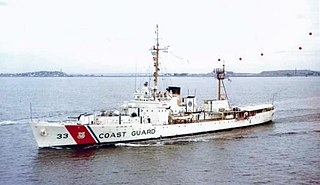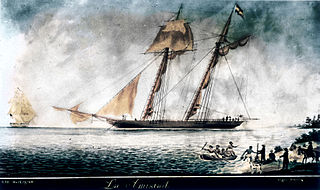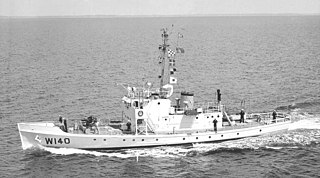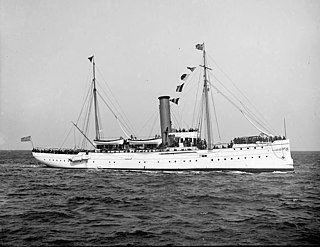Sources
- United States Coast Guard, USCGC Campbell History, http://www.uscg.mil/lantarea/cgcCampbell/history.asp, retrieved 2/15/2011
- United States Department of Commerce, Merchant Vessels of the United States, USG, 1889
USCGC Campbell may refer to more than one United States Coast Guard ship.

The United States Revenue Cutter Service was established by an act of Congress on 4 August 1790 as the Revenue-Marine upon the recommendation of Secretary of the Treasury Alexander Hamilton to serve as an armed customs enforcement service. As time passed, the service gradually gained missions either voluntarily or by legislation, including those of a military nature. It was generally referred to as the Revenue-Marine until 31 July 1894, when it was officially renamed the Revenue Cutter Service. The Revenue Cutter Service operated under the authority of the U.S. Department of the Treasury. On 28 January 1915, the service was merged by an act of Congress with the United States Life-Saving Service to form the United States Coast Guard.

Alfred Carroll Richmond was a United States Coast Guard admiral who served as the 11th Commandant of the United States Coast Guard from 1954 to 1962, the second longest tenure of any U.S. Coast Guard Commandant following Russell R. Waesche who served from 1936 to 1946.
One ship of the United States Navy and two ships of the United States Coast Guard have been named Bibb, in honor of George M. Bibb, senator from Kentucky and briefly Secretary of the Treasury in the Tyler administration.

The Treasury-class cutter was a group of seven high endurance cutters launched by the United States Coast Guard between 1936 and 1937. The class were called the "Treasury class" because they were each named for former Secretaries of the Treasury. These ships were also collectively known as the "327's" as they were all 327 feet (100 m) in length. The Treasury-class cutters proved highly adaptable, dependable, versatile and long-lived warships. Most served the United States for over 40 years, including with distinction and heroism through World War II, Korea, and Vietnam.

SS Bear was a dual steam-powered and sailing ship built with six-inch (15.2 cm)-thick sides which had a long life in various cold-water and ice-filled environs. She was a forerunner of modern icebreakers and had a diverse service life. According to the United States Coast Guard official website, Bear is described as "probably the most famous ship in the history of the Coast Guard."

Washington was a revenue cutter that served in the United States Revenue Cutter Service and in the United States Navy. She discovered, boarded and captured La Amistad after the slaves onboard had seized control of that schooner in an 1839 mutiny.
The history of the United States Coast Guard goes back to the United States Revenue Cutter Service, which was founded on 4 August 1790 as part of the Department of the Treasury. The Revenue Cutter Service and the United States Life-Saving Service were merged to become the Coast Guard per 14 U.S.C. § 1 which states: "The Coast Guard as established January 28, 1915, shall be a military service and a branch of the armed forces of the United States at all times." In 1939, the United States Lighthouse Service was merged into the Coast Guard. The Coast Guard itself was moved to the Department of Transportation in 1967, and on 01 March 2003 it became part of the Department of Homeland Security. However, under 14 U.S.C. § 3 as amended by section 211 of the Coast Guard and Maritime Transportation Act of 2006, upon the declaration of war and when Congress so directs in the declaration, or when the President directs, the Coast Guard operates as a service in the Department of the Navy.
The United States Revenue Cutter Ingham was one of the 13 Coast Guard cutters of the Morris-Taney class. Named for Secretary of the Treasury Samuel D. Ingham, she was the first United States warship to engage a Mexican ship in combat; and for her service in that battle, a newspaper called her Semper Paratus, which later became the motto of the United States Coast Guard. Ingham was sold in 1836 to the Republic of Texas and served in the Texas Navy until she was captured as a prize-of-war by Mexico and was rechristened Independencia.

USRC Seminole was a 188 ft (57 m), 845-ton United States Revenue Cutter Service steamer constructed by the Columbian Iron Works in Baltimore, Maryland for $141,000. She was commissioned in 1900 and saw service through 1934, when she was transferred to the Federal Emergency Relief Administration.
USCGC Harriet Lane refers to three ships of the United States Coast Guard:
Two ships of the United States Coast Guard or its antecedent services have borne the name Sherman, in honor of John Sherman (1823–1900), who was Secretary of the Treasury during the Hayes administration (1877–1881).
USCGC Tampa has been the name of four cutters of the United States Revenue Cutter Service and United States Coast Guard:
USCGC Mackinac has been the name of more than one United States Revenue Cutter Service and United States Coast Guard ship, and may refer to:
McCulloch or Hugh McCulloch has been the name of more than one ship of the United States Revenue-Marine, United States Revenue Cutter Service, or United States Coast Guard, and may refer to:
Dexter has been the name of more than one ship of the United States Revenue Cutter Service and United States Coast Guard, and may refer to:
USRC Active was the name of six vessels of the United States Revenue Cutter Service, and may refer to:
USRC Vigilant may refer to various ships of the United States Revenue-Marine (1790–1894) and United States Revenue Cutter Service (1894–1915):

USCGC Crawford (WSC-134), was a 125 ft (38 m) United States Coast Guard Active-class patrol boat in commission from 1927 to 1947. She was named for William H. Crawford, (1772–1834) who was appointed in 1816 as Secretary of the Treasury by President James Madison and he continued under President James Monroe through 1825. Crawford was the seventh vessel commissioned by the U.S. Revenue Cutter Service and the Coast Guard named after the former secretary. She served during the Rum Patrol and World War II performing defense, law enforcement, ice patrol, and search and rescue missions.
USRC Forward was the name of two vessels of the United States Revenue Cutter Service, and may refer to:

USRC Gresham was a cruising cutter and auxiliary gunboat built for the United States Revenue Cutter Service to patrol the Great Lakes. She was one of a series of cutters named for former U.S. Secretaries of the Treasury. Her namesake Walter Q. Gresham served as the 35th Secretary of the Treasury in 1884 and died in 1895 while serving as the 33rd U.S. Secretary of State. She became part of the newly created United States Coast Guard in 1915, and also served as a coastal convoy escort and patrol boat under United States Navy control during both World War I and World War II. After being decommissioned by the Coast Guard in 1944, she eventually came under Israeli control in 1947. She carried Jewish refugees from Italy to Palestine and later served in the fledgling Israeli Navy until 1951.